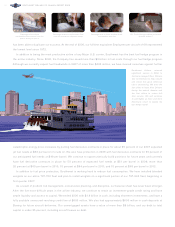Southwest Airlines 2006 Annual Report Download - page 21
Download and view the complete annual report
Please find page 21 of the 2006 Southwest Airlines annual report below. You can navigate through the pages in the report by either clicking on the pages listed below, or by using the keyword search tool below to find specific information within the annual report.Field and all states outside of Texas, with the
exception of the states of Alabama, Arkansas, Kan-
sas, Louisiana, Mississippi, Missouri, New Mexico,
and Oklahoma, which will be referred to as “Wright
Amendment States.” Flights between Dallas Love
Field and the Wright Amendment States have been
permitted only when an airline has not offered or
provided any through service or ticketing with
another air carrier at Dallas Love Field and has
not offered service to or from any point that was
outside of a Wright Amendment State. The Wright
Amendment does not restrict flights operated with
aircraft having 56 or fewer passenger seats. In addi-
tion, the Wright Amendment does not restrict
Southwest’s intrastate Texas flights or its air service
from points other than Dallas Love Field.
In the third quarter of 2006, Southwest entered into
an agreement with the City of Dallas, the City of
Fort Worth, American Airlines, Inc., and the DFW
International Airport Board. Pursuant to this agree-
ment, the five parties sought enactment of legisla-
tion to amend the Act. On October 13, 2006,
Congress responded by passing the Wright Amend-
ment Reform Act of 2006 (the “Reform Act”),
which provides for, among other things, (1) sub-
stantial repeal of the Wright Amendment in 2014,
(2) immediate repeal of through service and tick-
eting restrictions, so that Customers can purchase a
single ticket between Dallas Love Field and any
U.S. destination (while still requiring the Custom-
er’s flight to make a stop in a Wright Amendment
State), and (3) reduction of the maximum number
of gates available for commercial air service at Dallas
Love Field from 32 to 20. Southwest currently uses
14 gates at Dallas Love Field. Pursuant to the
Reform Act and local agreements with the City
of Dallas with respect to gates, Southwest can
expand scheduled service from Dallas Love Field
and intends to do so.
Safety and Health. The Company and its third-
party maintenance providers are subject to the jurisdic-
tion of the Federal Aviation Administration (“FAA”)
with respect to the Company’s aircraft maintenance and
operations, including equipment, ground facilities, dis-
patch, communications, flight training personnel, and
other matters affecting air safety. To ensure compliance
with its regulations, the FAA requires airlines to obtain
operating, airworthiness, and other certificates, which are
subject to suspension or revocation for cause. The Com-
pany has obtained such certificates. In addition, pursuant
to FAA regulations, the Company has established, and
the FAA has approved, the Company’s operations
specifications and a maintenance program for the Com-
pany’s aircraft, ranging from frequent routine inspections
to major overhauls. The FAA, acting through its own
powers or through the appropriate U.S. Attorney, also
has the power to bring proceedings for the imposition and
collection of fines for violation of the Federal Air
Regulations.
The Company is subject to various other federal,
state, and local laws and regulations relating to occupa-
tional safety and health, including Occupational Safety
and Health Administration and Food and Drug Admin-
istration regulations.
Security. Pursuant to the Aviation and Transpor-
tation Security Act (the “Aviation Security Act”), the
Transportation Security Administration (“TSA”), a
division of the Department of Homeland Security, is
responsible for certain civil aviation security matters.
The Aviation Security Act mandated, among other
things, improved flight deck security, deployment of
federal air marshals onboard flights, improved airport
perimeter access security, airline crew security training,
enhanced security screening of passengers, baggage,
cargo, mail, employees, and vendors, enhanced training
and qualifications of security screening personnel, addi-
tional provision of passenger data to U.S. Customs, and
enhanced background checks. Under the Aviation Secu-
rity Act, substantially all security screeners at airports are
federal employees, and significant other elements of air-
line and airport security are overseen and performed by
federal employees, including federal security managers,
federal law enforcement officers, and federal air marshals.
Under the Aviation Security Act, funding for passenger
security is provided in part by a $2.50 per enplanement
security fee, subject to a maximum of $5.00 per one-way
trip. The Aviation Security Act also allows the TSA to
assess an Aviation Security Infrastructure Fee on each
airline up to the total amount spent by that airline on
passenger and property screening in calendar year 2000.
Southwest was assessed a fee, and recorded expense,
totaling approximately $50 million in each of 2005
and 2006 (of which approximately $24 million in each
year is being contested by Southwest). Like the FAA, the
TSA may impose and collect fines for violations of its
regulations.
Enhanced security measures have had, and will
continue to have, a significant impact on the airport
experience for passengers. While these security require-
ments have not impacted aircraft utilization, they have
impacted our business. In particular, the third quarter of
2006 presented challenges to the airline industry due to
new security measures mandated by the TSA, as a result
2
























